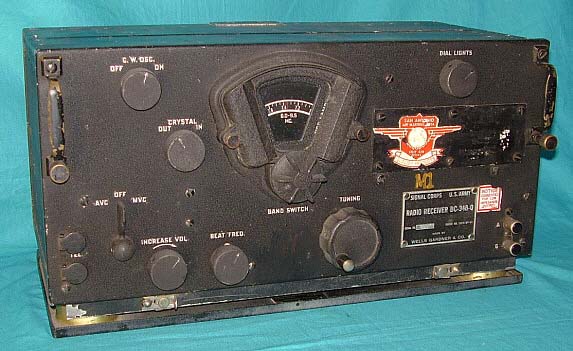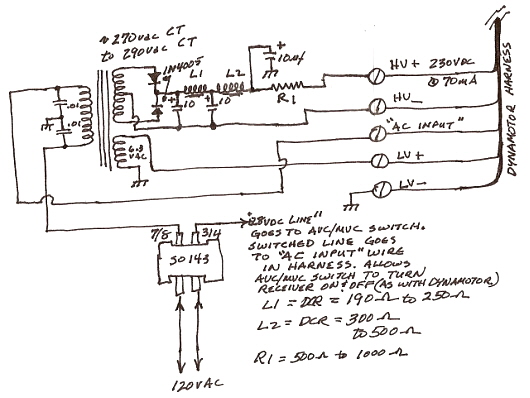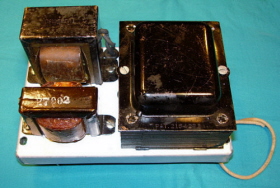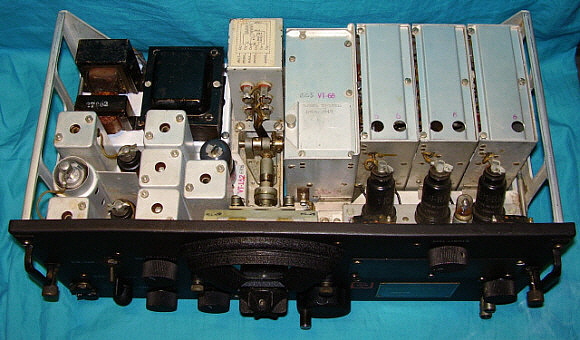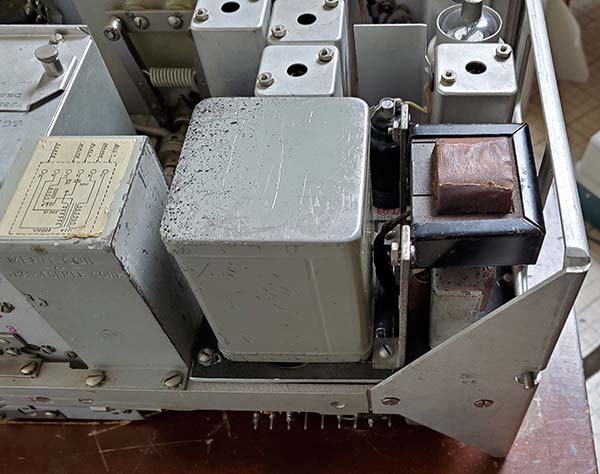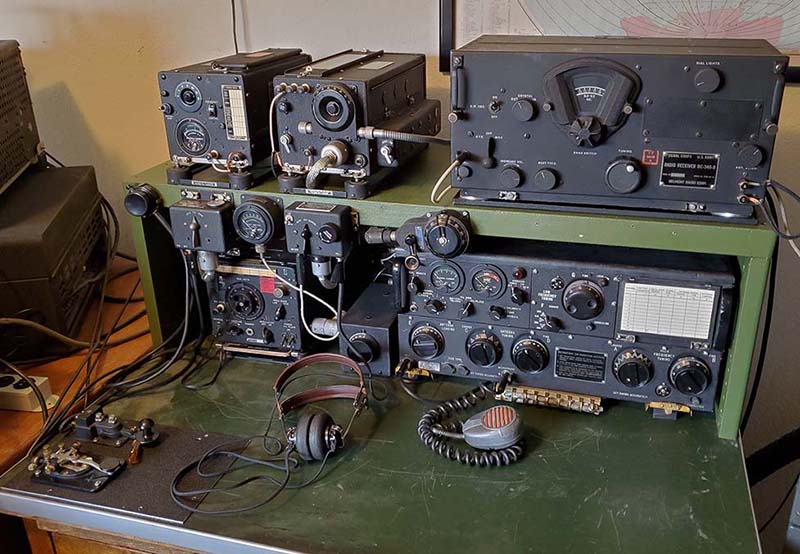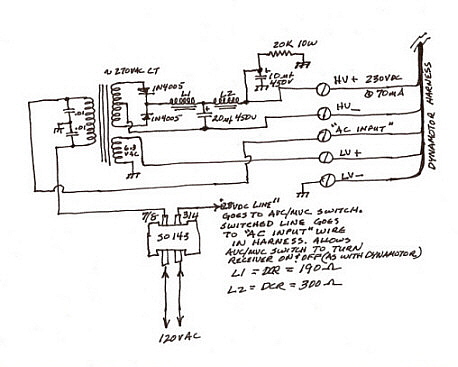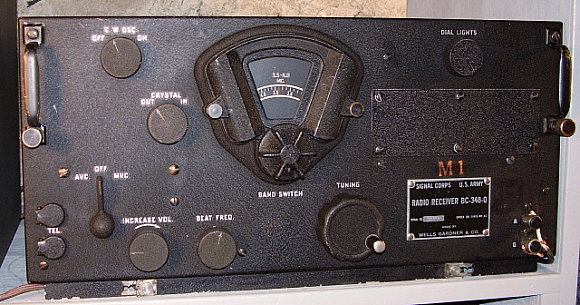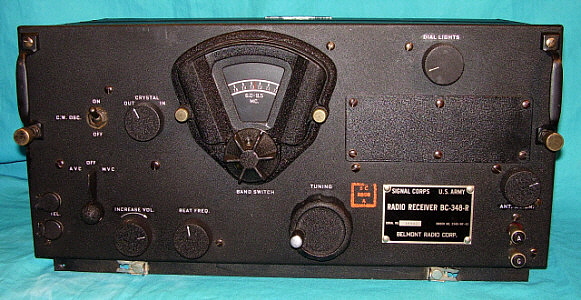| First off,...don't attempt this unless your receiver is
in really, really poor cosmetic condition because IT'S A LOT OF WORK!
However, some BC-348s are poor on the outside and really nice on the
inside, so a repaint is sometimes a necessity. You're going to need
about two or three cans of VHT High-Temp Black Wrinkle Finish Paint. It
is carried at most O'Reilly auto parts stores (also Summit Racing.) Be prepared, it's
expensive at around eleven dollars per can. Use a "spray can handle" as
this allows better control over the spray pattern. Also, use high
quality paint stripper. Remove all of the knobs, the handles, the small
panel, the dial cover and the phone jack "toilet-seat" covers. Unsolder
the wires to the dial lamps and to the Antenna terminal. Remove the
front panel. Keep all of the screws together because they will also be
painted. Drill out the rivets that mount the ID tag to the front panel.
You will also have to drill out the rivets that hold the two dial lamp
sockets to the panel. You can now strip the paint from the front panel,
the handles, the knobs and the smaller access panel.
The front panel, all knobs, the two pieces to the dial cover, the
phone jack toilet seat covers and the small access panel are to be
painted black wrinkle finish. The handles and the screw heads will be
painted black satin finish. Some of the original hardware was actually a
dark bronze finish but this was an oxide finish that is difficult to
accomplish (it's called Brown Patina and will work on brass hardware but
not steel.) Sometimes the brown finish can be duplicated with ink dyes
that combine brown and black to achieve the proper color. Some restorers just paint
the screw heads satin black but this is just a "short cut" that shows a
lack of commitment to originality.
First, though, a word or two on how to successfully paint wrinkle
finish paint. The original paint used on the BC-348 and all military and
commercial gear from the fifties on back was a two-part process that
required a base coat of nitrocellulose lacquer that was allowed to dry.
Then a catalyst was sprayed onto the lacquer base. The panels were then
put into ovens that baked the paint and the wrinkle developed in the
oven. That's why most vintage wrinkle paint jobs have the wrinkle on the
outside and smooth gloss black paint on the inside. The inside wasn't
sprayed with the catalyst.
Today, we use paint that is a one-part process that is heat
activated. I do all of my painting outside so the heat comes from
incandescent lamps. First, DO NOT pre-heat the metal to be
painted by putting in out in the sunlight or in an oven. This causes
activation of the wrinkle almost immediately when the paint hits the hot
surface and will result in very uneven coverage and spotty wrinkling.
Leave the metal at room temperature. Next, the paint has to be applied with very heavy
successive coats separated by just a few minutes. I use a minimum of
three heavy coats applied at different angles for each coat and separate
each application by a couple of minutes. Next, to apply heat I use 100
watt light bulbs in clip-on utility lamps with aluminum shades. These
are available at Home Depot for less than $10 each. I usually use three
lamps suspended over the panel about 10" to 12" above the panel. The
three lamps will heat the paint and the panel and the wrinkle process
will start in about 10 minutes. I now use two 250W brood lamps for
heat. The two lamps provide more heat that the three 100W lamps and are
easier to place correctly. I standby with a hand-held heat gun and
after about 10 minutes, when the wrinkling starts, I use the heat gun to
apply more heat around the corners and places where the lamps don't heat
the panel very well - I still do this and have found it a "necessary"
part of the wrinkling process. For stubborn areas, the heat gun will force the
wrinkle but don't apply too much heat or the paint will "gloss" and the
wrinkle won't match. After about another 5 to 10 minutes the wrinkling
should be complete and now remove all heat and let the panel cool down
for about 30 minutes. When the panel is cool, the paint will be set-up
enough to handle. Let the paint cure at least overnight before mounting any
screws or parts to the panel. If you can wait a little longer, like a
week, the paint will be much harder and resistant to scratching or other
types of damage. Thirty days are required for full curing and after
one year the paint is virtually indestructible.
Now comes the tedious part. You'll notice that the silver
nomenclature on an original front panel is bare aluminum. Originally,
after the panel was painted the paint over the nomenclature was "ground
off." Originally, the nomenclature was much higher and when just
"ground" down slightly, the bare metal showed through as silver
lettering. This time we can't do that since the lettering was already
ground down once and now the lettering is just above the paint level. I
make a small tool that consists of a small piece of an industrial razor blade piece about
.25" wide that is mounted to a small wooden handle. With this tool I can
carefully "shave" the wrinkle finish paint off of the nomenclature but
the lettering still isn't bright.
I also make another tool that is another small wooden handle that has
the end cut at an angle that has a flat surface. I use 400 grit aluminum
oxide paper held to the angled part of the handle with tape to polish
the lettering. This leaves the lettering looking very bright and
original. Sometimes there might be a minor slip-up but I use a small
paint brush to apply Artist's Acrylic Mars Black paint to touch-up
scratches or other blemishes I've caused during the process. >>> |
>>> To remount the ID tag,
you'll have to make "fake rivets." I use 4-40 SS (stainless steel)
binder head slotted screws. I chuck them up in a drill press and file
the head until you don't see the slot but there is still material left
to shape a rivet head. Don't use philips head screws because the slots
are too deep. After you have four good looking "fake rivets" mount the
tag and secure the "fake rivets" using 4-40 nuts on the back of the
panel. There is plenty of clearance for the nuts but don't use overly
long screws. Although you don't have to make "fake rivets" to remount
the dial lamp sockets be VERY CAREFUL about the back clearance when
remounting them with screws and nuts. Mount the binder head screws on
the back side of the panel and use the nuts on the dial lamp socket
side. You still might have to file the head of the screws to be sure you
have clearance. The distance between the back of the front panel and the
tuning dial mask is minimal. Without the clearance, you'll scratch the
dial mask the first time you change bands. Make sure you have the
clearance. Nowadays, I'd use the correct rivets - they are easily
available on eBay including the rivet setting tool. Next, paint the knobs and the other parts that should be black
wrinkle. Use a small scraper made out of a jeweler's file to remove the
paint from the "arrows" on the knobs. An Ex-acto knife with
the proper blade can also be used to remove the paint from the "arrow."
Some versions of the knobs appear that the arrow was engraved and some
version appear to be stamped into the wrinkle finish paint. The engraved
arrows clean out fine but the stamped arrows don't. Some vintage
drawings/photos show the knobs without any arrows. If you have the
stamped type arrows and are having trouble getting them to look correct,
it is acceptable to just leave the knobs black wrinkle and not bother
trying to scrape out the paint. Also, be sure to paint the handles satin
black but
the screw heads should be dark-bronze finish.
For the cabinet, I've had pretty good luck just shooting over lightly
sanded and very clean original paint with the VHT wrinkle finish and
then giving it the heat treatment. You might have to paint one side at a
time depending on your heat lamps. I usually do one side at a time
because I have better control of the wrinkle process that way. I also
use a handheld heat gun to apply heat to corners and edges that the
lamps don't heat enough. I have
stripped the cabinets and wrinkle finished and I suppose they look
slightly better but it's very hard to tell whether a repainted cabinet
has been stripped or just painted over.
What about
the Signal Corps acceptance stamps?
- Without a doubt, the repainted BC-348 looks
incomplete without the orange Signal Corps acceptance stamps. What I did
was to first make full scale drawings of what the typical acceptance stamp
looks like. This will have the square boarder with "SC" at the top, a
random number that was the inspector's identification and then an "A" at
the bottom. Also, I made another scale drawing of the "M1" stamp that is
on 90% of the BC-348s (MWO for Lo-Z audio output.) I then took the scale drawings to a stationary
office supply type store that makes rubber stamps. It costs about $15 to
$20 per stamp. Usually the square boarder on the "SC" stamp costs a
little more but you "gotta have it." Once you have the rubber
stamps, now you can apply your own acceptance stamps on any of your
repainted AAF
gear. I use Artist's Acrylic to mix up the proper orange color and use
water to thin the paint to a very wet mix. I then soak a cloth pad with
the orange paint to create an "ink pad." Be sure to practice on some
scrap pieces for a while. Also, be sure to have the stamp "runny
looking" and be sure to remember - none of the original stampings were
straight. After all, the inspectors were just stamping gear they had
tested or accepted - it wasn't anything special to them. The "M1" stamp
is usually a lighter, almost yellow-orange color ink and done the same
way as the "SC" stamp. In fact, the "M1" stamps are usually even
"runnier" looking. The "sloppier" the stampings looks, the more original
they look.
|
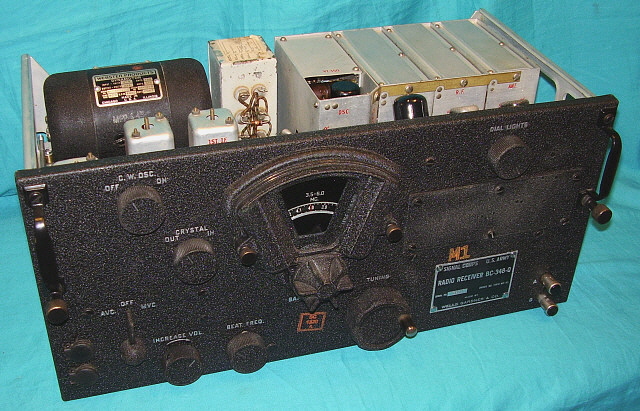
Take a look at BC-348-Q SN 11227 above. This BC-348 has been repainted as described in this section (with
the exception that I used Krylon BWF paint instead of VHT.) Also, the
Signal Corps acceptance stamps are made with reproduction stamps.
Overall, the impression of SN 11227 is that it is an excellent
condition, original BC-348. This is the effect we want to achieve in our
restorations. |
|
